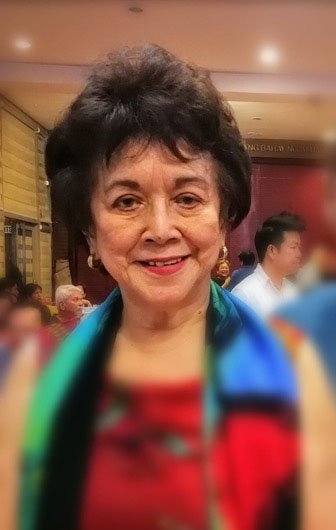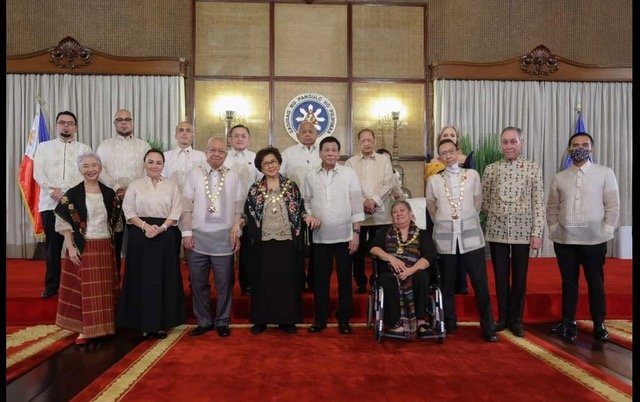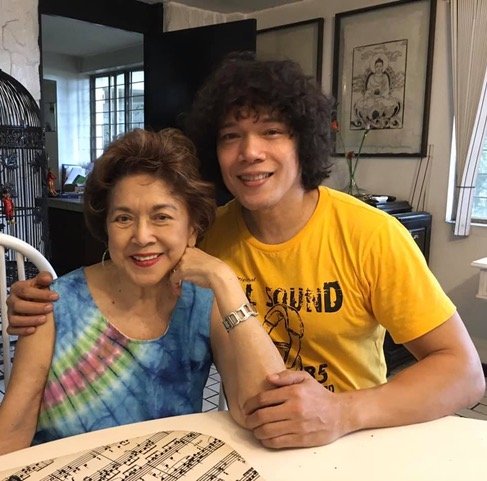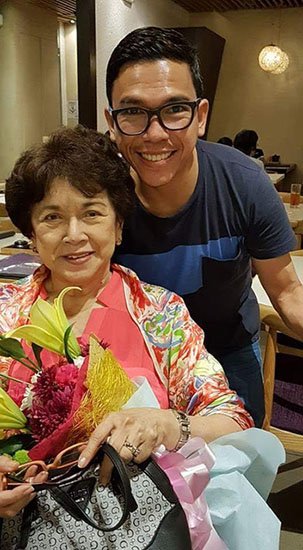Fides Cuyugan Asensio’s Musical Odyssey
/Fides Cuyugan Asensio as she looks now at age 90.
She was proclaimed National Artist for Music June 11, 2022 by virtue of Presidential Proclamation no. 1390 signed by President Rodrigo Duterte.
Fides Cuyugan Asensio (4th from left) with President Rodrigo Duterte and other National Artists Ricky Lee, 3rd from left; Agnes Locsin (seated) and Gemino Abad, 3rd from right; and their representatives.
Although she has sung and taught all her life, Asencio also has had a presence in cinema.
She was the star of the indie film Niño. Some years back, she was also in Peque Gallaga’s monumental Oro, Plata, Mata.
In the mid-‘80s after Oro, Plata, Mata, she was reunited with Gallaga in the CCP production of Francisco Feliciano’s opera La Loba Negra where she was one of two lead singers with the late soprano, Eleanor Calbes.
In the ’60s, she was on your living room TV in Sunday, Sweet, Sunday. For a while, she was Channel 7’s midnight attraction, hosting a late-night show on Filipino music.
Looking back, she was the first voice scholar accepted to the Curtis Institute in Philadelphia. That’s the same school where other Filipino artists made good: pianists Nena Villanueva del Rosario and Cecile Licad; and tenors Noel Velasco and Otoniel Gonzaga.
At the time in the ‘50s, Curtis was the most exclusive school in the world.
Recalls Asensio: “The finest teachers of every instrument and voice taught at Curtis. There were only 120 students housed in a huge mansion of the high-end main line Philadelphia. No taped auditions were acceptable. Aspiring scholars of voice and instruments (piano-violin, etc.) had to audition in person. If you come from as far away a country as Nena del Rosario and I did, too bad if you failed the audition. One had to spend for one’s fare to get to Philadelphia, PA.”
A music school in Quezon City carries her name: The Fides Cuyugan Asensio Institute of Music and Arts.
Naturally, her former students have reasons to cheer.
Recalls pop tenor Jonathan Badon: “The way Tita Fides encouraged me was reason enough for me to pursue music. In my college days, I’d say she believed in me more than I believed in myself. She helped me not only with my voice, but also with my confidence and self-expression as a person. She made me realize that music has the ability to touch people in a very special way. She not only contributed to my achievements but also to my personal and social development.
Fides Cuyugan Asensio with former student, tenor Jonathan Badon.
“Tita Fides has a great influence on me as a performer. Whenever perform, I always make it a point that the audience are all-focused on me before I start singing. Trying my best to impress the audience the moment I am on stage is important. First impression lasts. The audience should be in the palm of my hand, controlling their emotions. I learned that from my mentor Tita Fides. This I will cherish.
“I remember she always tells me ‘If you have it, you have it. I know you can do it. Don’t give up’! Those were the words she uttered whenever I felt discouraged and that really helped me overcome my fears. Mind over matter. And the most important thing she said was ‘You should have passion, passion… passion from within.’”
Another student is baritone, music teacher, and musical theater coach Marvin Gayramon from Butuan City.
Fides Cuyugan Asensio with former student Marvin Gayramon.
As someone from the “province,” Gayramon didn’t expect to have a productive career in music. “Maestra Fides went beyond her duties as a voice teacher. While she demanded that I focus on my bel canto placement as a conservatory student, she made sure that I was involved in her productions the areas of which include TV guesting, appearances in operas, musicals, concert tours, and shows. They constituted early internship of sorts. So, I plunged into music theater shows, concerts and voice competitions locally and abroad. I had such a strong model figure in Tita Fides that I began teaching musical theater and popular music styles to my voice students as early as my junior year in college.”
In 1995, Gayramon established the Aesthetics Voice Studio in Butuan City where he was able to produce champions in reality television singing shows who now have careers in the music industry as singers and recording artists. His mentor’s ability to shape and establish a sound technique in her students made him emulate her thought process as an effective performer and teacher.
“I am currently teaching classical voice to graduate students. I teach pop music to undergraduate students at the Philippine Women’s University School of Music. In that school, I get to apply Maestra Fides’ way of prescribing repertoire suitable to specific vocal needs of different students.”
A Musical Family
Asensio was born in Lucena, but her physician father, Dr. Gervasio Santos Cuyugan, a personal physician-surgeon of President Quezon, was from San Fernando, Pampanga. She got her Bicol connections from her mother, Jacinta Belza, who was a beauty from Buhi, Camarines Sur.
She came from a music-loving family.
Her mother was always playing on the piano simplified excerpts or piano music from grand opera. “I guess that is where I first had an aural glimpse into the exciting world of opera. My sister, Ceres, was the star pupil of Maestra Marcela Agoncillo. My brother, Ruben, was the star pupil of Maestro Ernesto Vallejo (the country’s first violin prodigy).”
“Asensio was the coloratura to reckon with in the ‘50s and the ‘60s.”
As librettist, her output has included Larawan at Kababaihan: Mukha at Maskara (music by Lucrecia Kasilag; Mayo-Bisperas ng Liwanag (inspired by Nick Joaquin’s “Mayday Eve”) with music by Rey Paguio; Spoliarium, an opera on the life of Juan Luna (music by Ryan Cayabyab); Why Flowers Bloom in May (also by Kasilag;) Song of Joseph, a musical on the life, love, and death of St. Joseph (music by Raymond Roldan) and La Loba Negra composed by Francisco Feliciano.
Asensio was the coloratura to reckon with in the ‘50s and the ‘60s. She made her professional debut as Adele in Die Fledermaus at the Far Eastern University Auditorium. Two years later, she sang the role of Sisa in the world premiere of Felipe de Leon's Noli Me Tangere with the Manila Symphony Orchestra.
Until the late ‘60s, Asensio appeared in numerous Filipino operas, including the world premieres of Ramon Santos' Mapulang Bituin, Eliseo Pajaros' Binhi ng Kalayaan, and Kasilag's Dularawan. Her repertoire also included roles from operas including Gretel in Hansel und Gretel, Lucia in Lucia di Lammermoor, Susanna in Il Segreto di Susanna, and Konstanze in Die Entfrung aus dem Serail.
She remembers Die Fledermaus simply because she considers it a fun opera. “It didn’t pose any vocal difficulty for me at my age. Besides I had great co- singers, director, conductor, and choreographer. They were Austrian Herbert Zipper and Trudl Dubsky Zipper who mounted an authentically correct staging.”
What other pointers from his Maestra would Gayramon cherish?
“It was through her prodding that I pursued higher learning which enabled me to finish my PhD in Music Performance after years of struggling to juggle my studies, performing, and teaching career all at the same time. For that, I am truly grateful. She was an advocate for excellence in the performing arts.”
Pablo A. Tariman contributes to the Philippine Daily Inquirer, Philippine Star, Vera Files and The Diarist.Ph. He is author of a first book of poetry, Love, Life and Loss – Poems During the Pandemic. He was one of 160 Asian poets who made it in the anthology, The Best Asian Poetry 2021-22 published in Singapore. Born in Baras, Catanduanes, he has three daughters and six grandchildren.
More articles from Pablo A. Tariman







